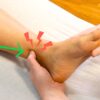Getting to the core of the issue
First off, what is this strange sounding condition?
Diastasis Recti is most common among pregnant or postpartum women. About two thirds of pregnant women have it. So why have you never heard of it? People don’t talk about it! And hardly anyone knows that massage therapy for diastasis recti can help.
The facts:
Diastasis Recti is a condition where the rectus abdominis splits down the middle causing a vertical gap in the abdominal muscles. It can cause lower back pain, constipation, and urine leaking. It can even make it harder to breathe and to move normally.
How to treat it if you have it:
Massage therapy for Diastasis Recti can be very helpful to rebuild proper abdominal tone as long as you’re also working with a physical therapist who specializes in this issue. An experienced massage therapist can open stuck tissues that are pulling the abdominal muscles outward. These stuck tissues are generally from previous injuries that have left scar tissue behind. In addition to this kind of bodywork, you’ll need physical therapy exercises to knit the torn muscles back together.
Why “ab” exercises don’t work for you for now…
It’s counter-intuitive, but doing “ab” exercises such as sit ups, or pilates, can often make the problem worse. Without proper firing of the correct support muscles, these exercises often pull outwards on the linea alba (centerline where the gap develops). This can either increase the separation, or keep it from knitting back together.
A combination of massage and physical therapy can speed up the healing process considerably. In most cases it will open up the stuck tissues that would keep physical therapy exercises from working. The synergy between the two modalities is worth way more than the sum of the parts.
Why?
Because massage therapy is an “opening” practice. Our training is in releasing tissues that are either tight (ie over-firing) or stuck (ie glued with scar tissue). We also work to retrain the nervous system to allow muscles that are over-firing to relax and settle into a balanced tone. Restrictions elsewhere in your body such as rounded shoulders, tight hips, and misaligned ankles can all create stress on the abs and pull them further apart. Working on opening movement in these areas will allow the body to conversely work on closing the diastasis.
Physical Therapy is a “closing” practice. It’s based in strengthening and tightening muscles that are weak (ie under-firing). The repetition of certain exercises draw blood flow to areas that need it, allowing the body to heal and reconstruct itself.









Thank you for posting this! I am a massage therapist looking for information on this topic. This is about all I can find.
As David mentions in the article, not all abdominal exercises will help when someone is suffering from diastasis recti. If you work one-on-one with an experienced Pilates instructor (along with a physical therapist) they can help determine which abdominal exercises are most appropriate for you!
Thanks Rachel! Most basic pilates work will do wonders…and clients with a diastasis are going to have a very difficult time at first doing any without pushing the abs out. Getting transverse abdominus to fire in even the smallest ways is key, and then slowly but surely building up it’s strength from there. Wearing a brace with the linea alba knits itself back together is also worth exploring!
Pingback:
Outstanding story there. What happened after? Thanks!
Everything is very open with a very clear description of the issues.
It was really informative. Your site is very helpful.
Thanks for sharing!
Hello I am so grateful I found your site, I really
found you by mistake, while I was researching on Google for something else, Anyways
I am here now and would just like to say thanks a lot for
a fantastic post and a all round interesting blog (I also love the theme/design), I don’t have time to read through it all at the moment but I
have bookmarked it and also added in your RSS feeds, so
when I have time I will be back to read a lot
more, Please do keep up the fantastic b.
Pingback:
Pingback: